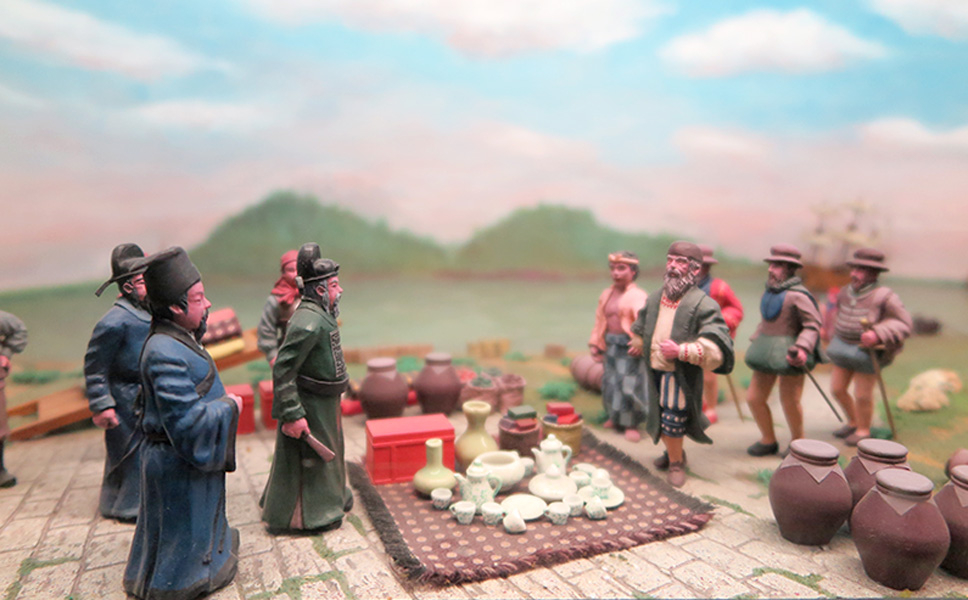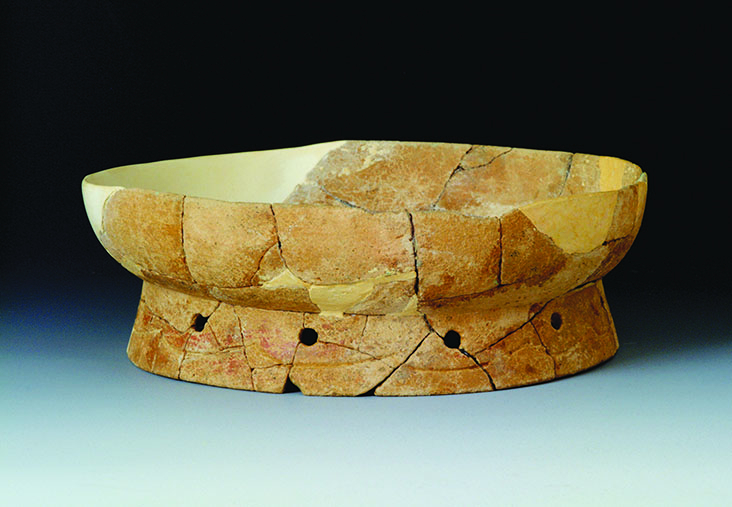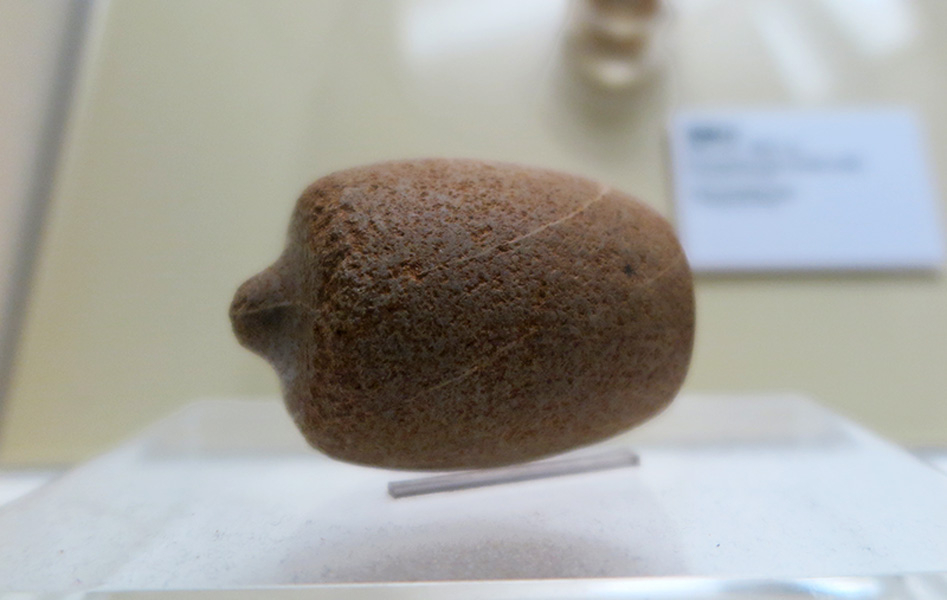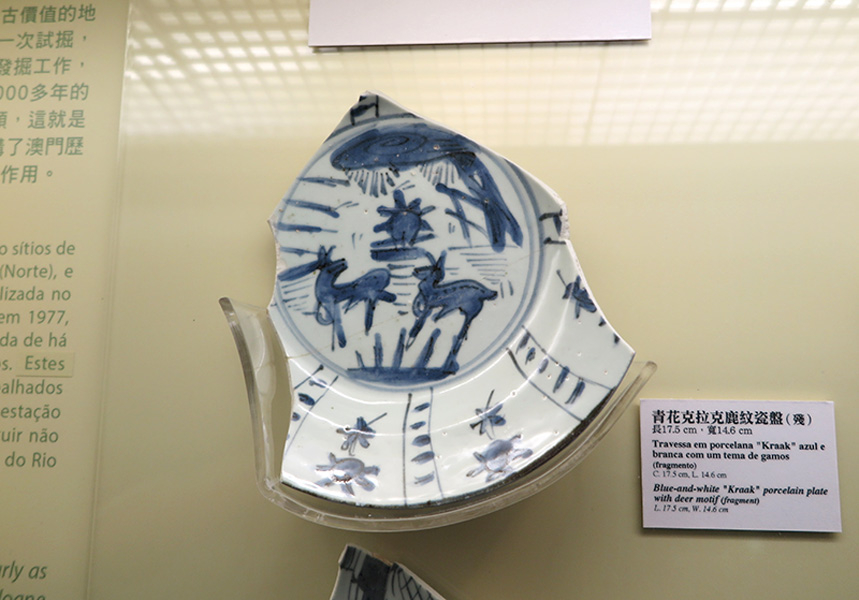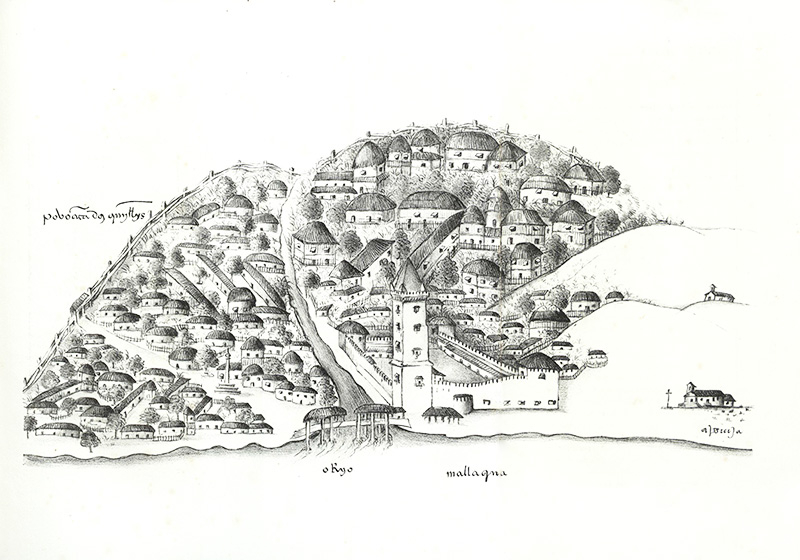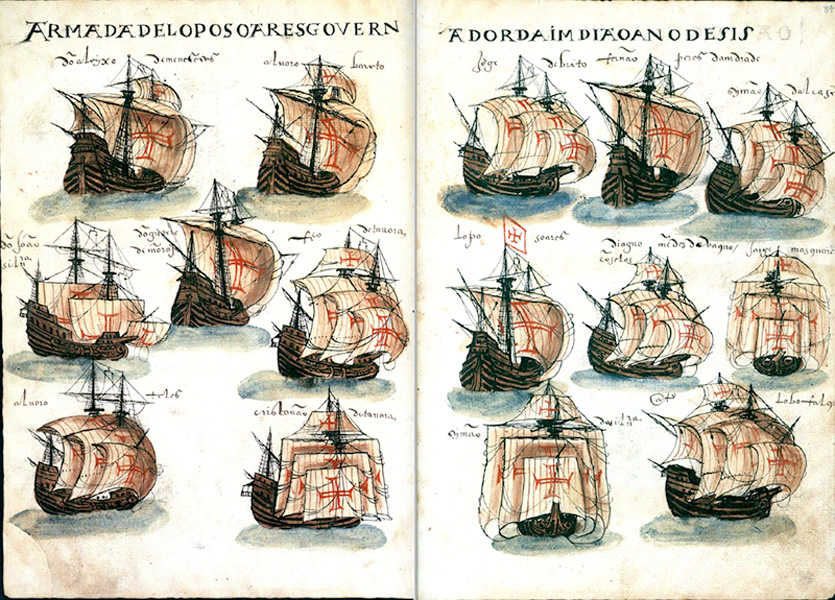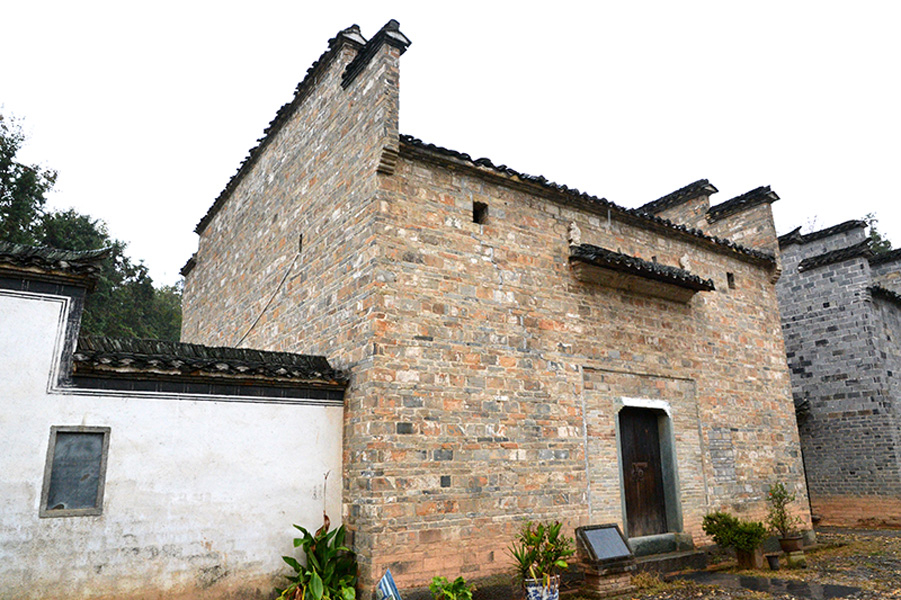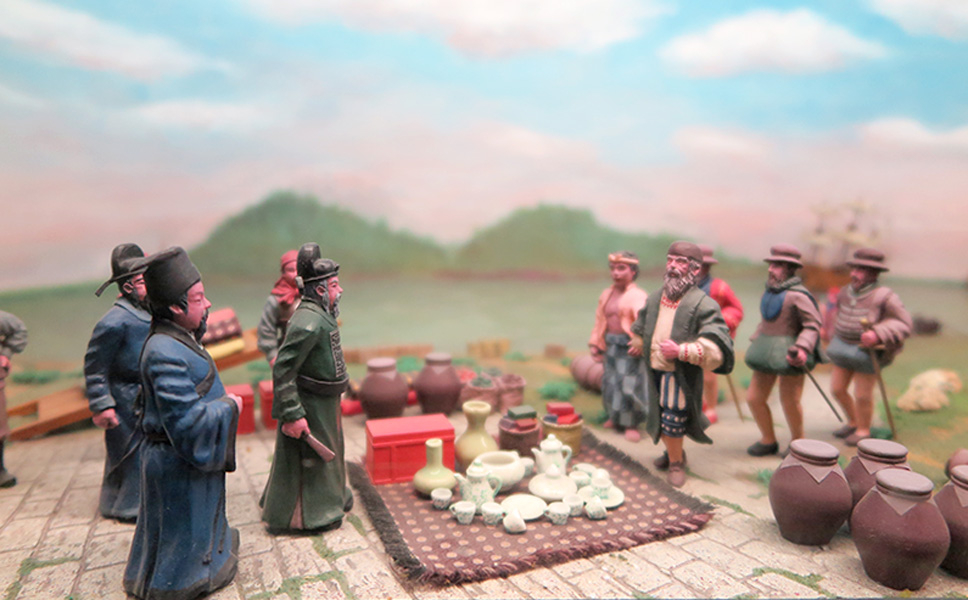In the 16th century, the Portuguese arrived in the South China Sea to seek trade opportunities with Ming (明朝) China and were finally granted residence in Macao (Macau) in 1557. However, human activities in Macao and its neighbouring areas date back to thousands of years ago.
In the late 20th century, archaeologists from Hong Kong and Macao made several excavations on the Island of Coloane, Macao. Archaeological findings suggested that there were human activities 6,000-7,000 years ago (late Neolithic Age) in the vicinity of Hac Sa, Macao, and a close cultural connection with the Pearl River Delta. Macao was established during the Qin (秦朝) and Han (漢朝) dynasties and was put under the administration of Xiangshan County (香山縣) in 1152.
The Portuguese Jorge Álvares arrived on the Island of Tamão in the estuary of the Pearl River in 1513. He was the first European to arrive in China by sea. However, the Portuguese diplomatic mission that arrived later experienced setbacks in China and the diplomatic relations between the two countries became strained. The Portuguese then commenced smuggling along the Chinese coast, which continued until 1553 when the Commissioner of Coastal Defence Wang Bo (汪柏) and the Portuguese Captain Leonel de Sousa reached an agreement that allowed Portuguese to trade in China. The Ming court permitted Portuguese settlement in Macao in 1557, marking Macao’s opening-up.
|
|
What is the story behind the name Macao? How did Macao open up? |
|
|
See answer below. |
The Municipal Council of Macao invited members of the Hong Kong Archaeological Society to conduct a field survey in Hac Sa Park in 1977. Scholars found and restored debris of painted pottery plates. (Collection of the Macao Museum of Art)
An excavation team formed by the Chinese University of Hong Kong and the University of Macau found a ring stone in the Hac Sa site in 1995. Scholars believe it was made with a rotary bearing in combination with a rotating disc for processing jade. (Collection of the Museum of Macau)
The Hac Sa site was the first location in Macao where archaeological excavations took place. In 1972, the Hong Kong Archaeological Society did field surveys in areas on the Island of Coloane including Hac Sa, Cheoc Van, Ka Ho, and Coloane urban area. A large number of relics were found in the area of Hac Sa Park. Later, excavations carried out in the years 1973, 1977, 1985, 1995, and 2006 uncovered Neolithic stoneware and pottery shards. These remains show traces of human activities 6,000-7,000 years ago. They also manifested a cultural connection between Macao and the Pearl River Delta.
In 1995, archaeologists from the Chinese University of Hong Kong and the University of Macau discovered a jade workshop in the Hac Sa site where they unearthed ornaments such as rings and slotted rings, and materials such as lithic cores, and stone slabs as well as tools such as ring stones and hammerstones. The findings were invaluable to the research on the prehistoric craft of jade in southern China.
Besides the Hac Sa site, the blue-and-white porcelain “Kraak” made in the Ming and Qing (清朝) dynasties was also unearthed at places such as the Ruins of St. Paul’s and Mount Fortress. (Collection of the Macao Museum of Art)
A bronze bust of Vasco da Gama. His Portuguese fleet reached Calicut, India, in 1498, marking the establishment of a Eurasian sea route.
Portugal invaded Malacca in 1512, extending its influence to Southeast Asia and the Far East.
The statue of Jorge Álvares in front of the old court building in Praia Grande Bay, Macao. Álvares was the first Portuguese who discovered China when he reached the Chinese Island of Tamão from Malacca on a Chinese sailboat in 1513.
After Jorge Álvares’ arrival in China in 1513, the Portuguese King Manuel I sent a diplomatic and trade mission to China. Under the recommendation of the Governor of Portuguese India, Lopo Soares de Albergaria, Tomé Pires was sent to China as the Portuguese envoy. Initially a chemist at the Portuguese court, he was later appointed as Feitor (the overseer) and sent to Asia. He wrote about his experiences in China in the book Suma Oriental.
The mission came ashore in 1517. They planned to pay tribute to the Ming court but were rejected. The mission’s interpreter Khoja Hussain then bribed eunuchs in Guangdong Province (廣東) to let the Portuguese pass as Malacca envoys so that they could re-enter the capital city (Portugal occupied Malacca, a Ming’s tributary state, in 1512). The mission had an audience with Emperor Zhengde (正德) in 1520. However, the emperor died the next year. Khoja Hussain was executed for having colluded with the emperor’s confidant Jiang Bin (江彬) and the Portuguese mission’s identity was exposed. As a result, they were escorted to and imprisoned in Guangzhou (廣州) by the newly crowned Emperor Jiajing (嘉靖). No records on their whereabouts were found.
While Tomé Pires was imprisoned, the Guangdong Commissioner of Coastal Defence Wang Hong (汪鋐) was driving off Portuguese fleets near the Island of Tamão. After enduring several days of siege, the Portuguese fleets withdrew to Malacca. In 1522, a Portuguese nobleman Martim Afonso de Melo Coutinho led a fleet to China for negotiation with the Ming court only to be repulsed in Sizihwan by the navy commanded by Wang. Diplomatic and military setbacks diverted the Portuguese attention to smuggling along the Chinese coast.
The Portuguese Armadas da Índia in 1515. The Portuguese King Manuel I sent the newly appointed Governor of Portuguese India, Lopo Soares de Albergaria, to Asia with a fleet of 15 caravels. A squadron of the fleet was a mission to China led by Fernão Pires de Andrade.
The Ming author Zheng Ruozeng (鄭若曾) mentioned the Portuguese cannon in his book on sea defence Chouhai Tubian (Illustrated Book on Maritime Preparedness, 《籌海圖編》). What the Chinese called Folangjichong (佛郎機銃) was a breech-loading swivel gun introduced to China by the Portuguese for sea defence.
Although the Ming court originally banned the Portuguese from trading in China, the Chinese demand for imported goods grew due to the national prohibition of maritime trading. The Sino-Japanese trade was also interrupted by the Ningbo Incident (寧波之亂) in 1523. Smuggling rings thus plagued the coast of Fujian (福建) and Zhejiang (浙江) Provinces. These smugglers became trading partners with the Portuguese and together they formed a base on the Island of Liampó near Ningbo.
Fernão Mendes Pinto described the bustling island in his Pilgrimage that there were over 3,000 inhabitants on the island, among which 1,200 were Portuguese. The rest came from all over the world. 300 mixed marriages were made with Portuguese women or mixed-race women. There were two hospitals and the Holy House of Mercy. Annual expenditure on these places amounted to 30,000 cruzeiros. Meanwhile, the city council’s annual income was a little over 6,000 cruzeiros. People said that the Island of Liampó was more impressive than any Portuguese settlement in India. Its scale also ranked top of its kind in Asia.
Pinto’s description may be exaggerated, but Liampó port did become a base for smugglers. However, its undue prosperity caught the attention of Zhu Wan (朱紈), the Governor of Zhejiang. He expelled the Portuguese and locked down Liampó port in 1548. The Portuguese fled to the Islands of Shangchuan (上川島) and Lampacau in Guangdong, their new bases for smuggling activities, until Macao opened up.
The former residence of Wang Bo in Jingdezhen Ancient Kilns & Folk Customs Expo Area (景德鎮古窰民俗博覽區), Jiangxi Province (江西). Wang was the first Ming official to permit the Portuguese to trade with China. (Photo credit: Fotoe)
In the Guangdong Chronicle (《廣東通志》), the Ming official Guo Fei (郭棐) wrote that in 1553, the Commissioner of Coastal Defence Wang Bo took bribes from the Portuguese and allowed them to reside in Macao. However, a Leonel de Sousa’s report in 1556 recorded that he negotiated with Wang and the two sides agreed on the Portuguese trading activities in China. The Portuguese started settling in Macao in 1557, opening up the city as a trade port.
|
|
What is the story behind the name Macao? How did Macao open up? |
|
|
Macao’s name bears the marks of its geography. Macao or Aomen (澳門) used to be called Haojing (濠鏡) or Haojiang (濠江). The former refers to the smooth water surface in the area, while the latter implies that the area produces oysters, where the Chinese characters “濠” and “蠔” both pronounced as “hao” are interchangeble. The character “ao (澳)” stands for port or harbour. In the Ming dynasty, authorities in Xiangshan County referred to Macao as Haojingao (濠鏡澳) or Xiangshanao (香山澳). The story behind the character “men (門)” is less clear. Some say it stands for the Shizimen (十字門) water body on the southwest of the Macao Peninsula. There is an outer Shizimen and an inner Shizimen. The former lies among the Islands of Taipa, Coloane, Great Hengqin (大橫琴島) and Small Hengqin (小橫琴島). The latter is enclosed by the Macao Peninsula, the Islands of Taipa, Small Hengqin and Wanzai (灣仔). Every ship heading for the inner harbour of Macao must go through Shizimen. Others say the “men” means the gate to Macao formed by the Guia Hill and the Penha Hill standing opposite each other on the eastern and western side of the Macao Peninsula. Opinions also vary on how and why Macao opened up. The most widely accepted explanation is found in the Guangdong Chronicle (the volume on Wanli﹝萬曆﹞reign of the Ming dynasty) compiled by Guo Fei. It mentioned that in the year 1553, foreign merchants requested access to Haojingao to dry their goods because their vessels were damaged. The merchants bribed Wang Bo who permitted their stay in Macao. However, scholars have found that in Leonel de Sousa’s report to the Portuguese court in 1556, a negotiation took place between the Portuguese and the Commissioner of Coastal Defence (which is believed to be Wang ) that resulted in an agreement to Portuguese trade in China provided they pay tribute to the Ming court. In 1554, the Portuguese started trading in Macao. In 1557, they officially gained residence in Macao, marking the establishment of Macao’s opening-up. The suggested reasons why Wang granted permission to the Portuguese diverged. Many believe that Wang took bribes from the Portuguese because Leonel de Sousa admitted that the Portuguese gifted Chinese officials several times. The bribes, some say, gave rise to the practice of land tax leverage in Macao. Some suggested that the Portuguese had ambergris, a substance the Chinese court sought from Guangdong officials several times, according to the Mingshizong Shilu (Veritable Records of Emperor Shizong, 《明世宗實錄》). Wang used ambergris as a bargaining chip for the court’s approval of the negotiations. Other proposed that the Portuguese earned their residence in Macao by facilitating the Ming court in repelling the pirate Zhang Xilao (張西老). Around that period, the Portuguese did, in fact, take part in several crackdowns on pirates launched by the Ming court. |
Photo courtesy of Mr. Alex Lou, Vice Chairman of The Heritage Society, unless otherwise specified.




